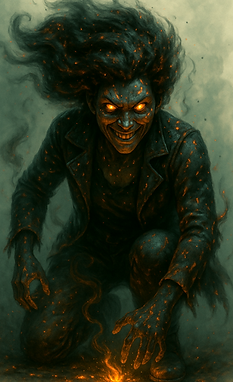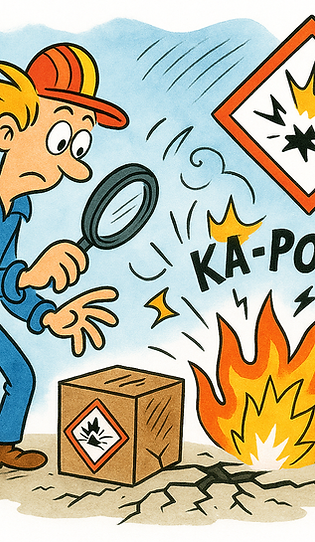
October
Fire Safety - Hot Work


Backdraft Banshee — The Doorway Ghost
She hides in trapped smoke and pressure; one wrong door and she screams. If smoke surges, air “breathes” at cracks, or your LEL climbs, don’t open it — pull back, evacuate, and wait for trained ventilation.
Hot Work Villains
Stay sharp—because the Hot Work Villains never take a day off.

Cyclone Cylinder — Pressurized Terror
He howls from dented tanks and leaking valves — a hiss today, a missile tomorrow. Spot dents or missing caps; if you hear a hiss, evacuate, tag it out, and call trained personnel.

Spark Slinger — The One-Ember Arsonist
He places sparks that can ride a breeze for 35+ feet into dust, rags, or pooled solvent. Clear combustibles 35 ft from hot work, use spark shields, stage an extinguisher, and stop work if you feel a draft.

Ember Wraith — The Patient Re-Igniter
She buries embers in ash and fabrics and teams up with oxidizers to wake a sleeping blaze. Probe for heat, cool thoroughly, monitor for hours — and if oxidizers are present, retreat and call specialists.
WEEK 1

Fire Triangle, Fuels & LEL Detection
Step into the ring with Spark Slinger, Ember Wraith, and Backdraft Banshee! This week we break down the fire triangle — heat, fuel, and oxygen — and show how knocking out just one side keeps the villains from ever lighting up. From sparks to dust clouds to hidden vapors, you’ll learn how to stop fires before they start
Because every spark we stop is another way we make sure you get home safe.
Multiple Choice 1.A worker notices the flame pictogram on an ethanol drum in a fab bay. Sparks from grinding land nearby. What hidden hazard is most likely? A) Liquids are heavy and stay put B) Vapors spread across the floor unseen C) Sparks bounce off the drum harmlessly D) Drums neutralize sparks inside 2.Why is leaving an uncapped solvent container with the flame pictogram dangerous near hot work? A) Vapors can spread invisibly and ignite B) Liquid won’t evaporate fast enough to matter C) Vapors neutralize sparks D) The container blocks oxygen flow 3.The Fire Triangle is made of heat, fuel, and: A)Smoke B)Oxygen C)Pressure D)Dust 4.Fires can develop in as little as: A)10 Seconds B)10 Minutes C)1 Hour D)1 Day 5.About how many industrial fires per year are started by hot work sparks? A)1,000 B)3,300 C)10,000 D)30,000 6.Invisible vapors are dangerous because: A)They’re harmless B)They can ignite before being seen C)They’re heavier than air D)They cool surfaces 7.If oxygen rises above 21%, fires: A)Slow down B)Burn hotter C)Go out D)Release less smoke 8.Spark Slinger produces sparks hotter than: A)300°F B)800°F C)1,200°F D)2,000°F E)Smoke Limited Response 1.Fires burn faster in enriched atmospheres above __________% oxygen. 2.NFPA data shows hot work sparks start about __________ industrial fires each year. 3.The three sides of the Fire Triangle are heat, fuel, and __________. Discussion 1.Which side of the Fire Triangle do you personally think is the hardest to control on our site — heat, fuel, or oxygen — and why? 2.Have you ever seen a “near miss” where a small spark or smolder almost turned into a fire? 3. Which side of the triangle could have been broken to stop it?
WEEK 2

Fire Watch: The Unsung Heroes
Not all heroes wear capes — some carry extinguishers! This week shines the spotlight on the Fire Watch, the guardian who keeps Spark Slinger’s sparks and Ember Wraith’s smolders from coming back to life after the crew leaves. Discover why 60 minutes of vigilance can save an entire site.
Because standing watch means standing up for each other’s safety.
Multiple Choice 1.OSHA requires combustibles cleared at least: A)10 ft B)25 ft C)35 ft D)50 ft 2.Fire Watch must remain at least: A)15 min B)30 min C)45 min D)90 min 3.NFPA data shows sparks can travel up to 35 ft, but drafts can extend that distance by more than: A) 5 ft B) 10 ft C) 15 ft D) 30 ft 4.Fire Watch must patrol: A)Just the welder’s side B)Above, below, and behind barriers C)Only the floor D)Only the roof 5.Cylinders must be stored: A)On their side B)Upright, capped, chained C)Dragged to the job D)Covered with rags 6.What’s the correct action if sparks drop behind a shield? A)Ignore it B)Stop work or reposition C)Wave it away D)Add cardboard 7.What hazard makes Fire Watch critical near cylinders? A)Noise B)Sparks damaging hoses/valves C)Dust D)Vibration 8. Why does the gas cylinder pictogram signal a fire concern, even though compressed gases don’t burn on their own? A)Cylinders always explode when hot B)Leaks or damaged valves can feed a fire with fuel or oxygen C)All gases are flammable by default D)Cylinders block exit paths Limited Response 1.Fire Watch must patrol __________, below, and behind barriers to catch hidden sparks. 2.A cylinder without a protective __________ can become a deadly projectile if the valve breaks. 3.A cylinder can rocket through a wall at speeds of over __________ miles per hour if the valve shears off. Discussion Points 1.What’s the most common mistake you’ve seen Fire Watches make, and how would you correct it? 2.Fire Watch is often seen as “boring.” How do we make the role respected and understood as lifesaving?
WEEK 3

Culture & Readiness: Building the Fortress
Permits, planning, and culture — these are the walls of our fortress against fire. This week, we focus on how a strong safety culture keeps the villains locked out. From daily housekeeping to signed permits, every choice you make strengthens our defenses and shows we don’t cut corners when lives are on the line.
Because when our culture is strong, it proves we care about every person on the crew.
Multiple Choice 1. Permits are required whenever: A)Job is over 1 hr B)Welding, cutting, or grinding outside a safe area C)The welder is new D)It’s night shift 2. Forging or reusing permits is: A)Common practice B)A cultural failure C)Sometimes acceptable D)A shortcut 3.What percentage of hot work fires occur with no valid permit? A)5% B)15% C)25% D)50% 4. Housekeeping failures cause what percentage of industrial fires? A)5% B)20% C)40% D)60% 5. Using compressed air to sweep dust risks: A)Cooling floors B)Dust explosions C)Noise complaints D)Vacuum failure 6. Why is “we’ll clean up after the job” dangerous? A)Supervisors dislike it B)Fuel stays present C)It wastes time D)Dust isn’t fuel 7.Which shortcut weakens culture the fastest? A)Cleaning too often B)Forging permits C)Daily housekeeping D)Extra signatures 8.Why is using compressed air for cleanup dangerous around fine dust? A)It makes the floor slippery B)It pressurizes dust into explosive clouds C)It lowers oxygen concentration D)It spreads dust evenly Limited response 1.NFPA data shows about __________ percent of industrial fires are linked to poor housekeeping. 2.Compressed air should never be used for sweeping dust, because airborne dust plus a spark can cause an __________. 3.NFPA data shows that 1 in ________ industrial fires are caused by poor housekeeping. Discussion 1.What small daily habits show that a crew has a strong safety culture? 2.What’s harder — stopping unsafe shortcuts in yourself, or calling them out in others? Why?
WEEK 4

Firefighting Skills: Step up if you Must
When the alarm sounds, the heroes step up! This week is about knowing when to fight, when to flee, and how to use the PASS method like a pro. Learn to pick the right extinguisher, size up a fire in seconds, and make the call that keeps your crew safe. Real heroism isn’t about charging in — it’s about getting everyone home.
Because true heroes measure success by protecting people, not just property.
Multiple Choice 1.Before fighting, always keep your back to the: A)Fire B)Exit C)Crew D)Doorway 2. A portable extinguisher typically discharges for: A)6–8 sec B)8–10 sec C)10–12 sec D)20 sec 3.PASS means Pull, Aim, Squeeze, and: A)Sweep B)Spray C)Stream D)Suppress 4.Which extinguisher is the class for liquids like gasoline? A)A B)B C)C D)D 5.Which class is for energized cords/panels? A)A B)B C)C D)D 6.Which class is for burning metals? A)A B)B C)C D)D 7.Extinguishers must be inspected at least every: A)Week B)Month C)Quarter D)Year 8. Mixing oxidizers with solvents, rags, or wood creates: A)A stable storage condition B)A powder keg ready to ignite C)A fireproof coating D)Harmless ash Limited Response 1.A portable fire extinguisher typically discharges for about __________ seconds. 2.The PASS method stands for Pull, Aim, Squeeze, and __________. 3.The SDS pictogram for oxidizers is shown as a flame over a __________. Discussion 1.How do you decide when to fight a fire versus when to evacuate? 2.Have you ever seen an extinguisher that was blocked, damaged, or empty? What culture steps can prevent that?
Cenutrion Safety Hub
Safety Tools for Craft Workers

.png)
.png)


